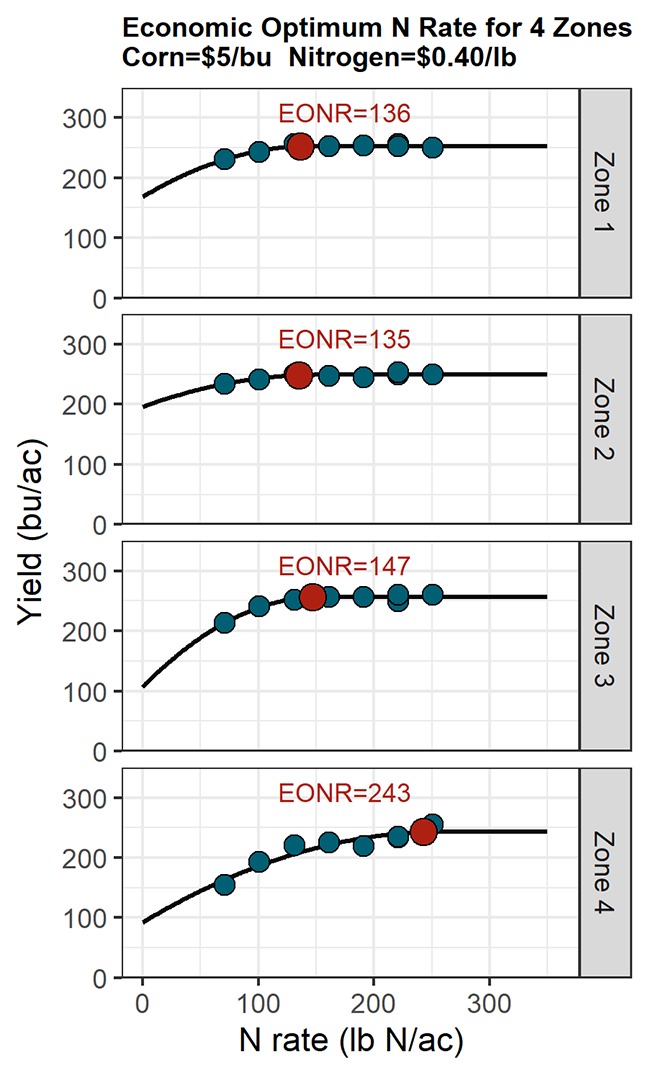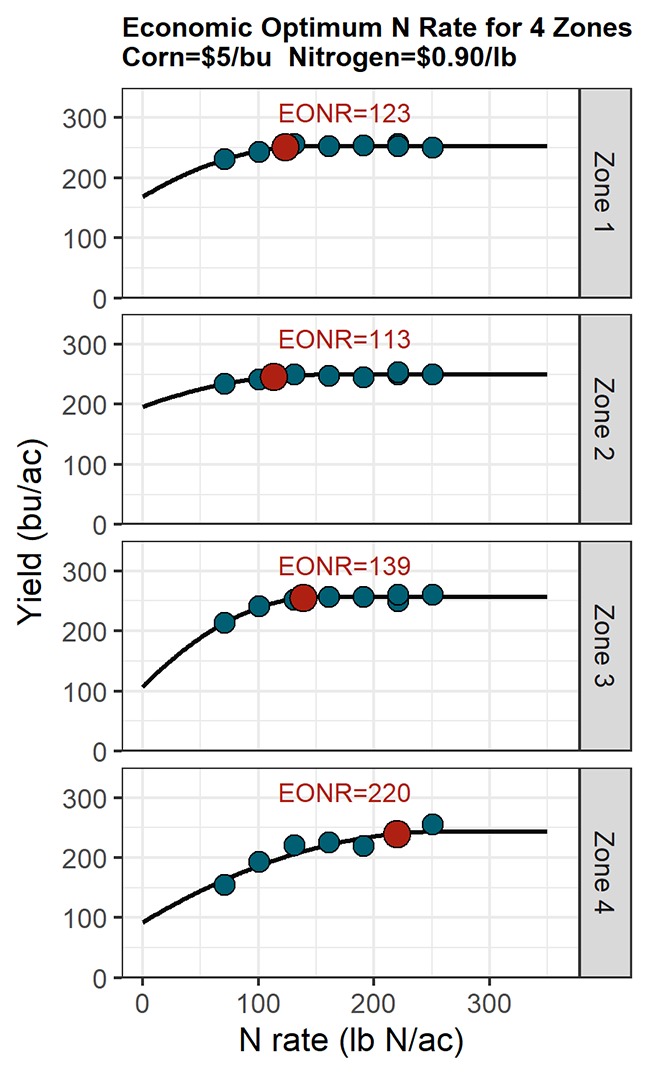By Laura Thompson and Laila Puntel
With harvest wrapping up, many are looking ahead at nitrogen (N) fertilizer plans for the year. In a growing season with high fertilizer prices like the upcoming 2022, varying the amount of N within the field could result in cost savings and yield increase, boosting your overall field profit. For example, if parts of your field have high or low organic matter, or high and low yielding areas, variable rate N application can target the actual needs of the field without spending extra cost in areas that would not pay off in yield.
In one field in 2021, we evaluated eight N rates ranging from 70 to 250 lb-N/ac applied in contrasting yield zones. Yield for each N rate and zone were determined using a yield monitor and the economic optimum N rate that maximizes profit was calculated for 2021 and 2022 price scenarios (Figure 1). The economic optimum N rate varied greatly in different portions of the field based on elevation, which influenced drainage, soil moisture, crop yield, mineralization and nitrogen losses. Using the 2021 price scenario ($5/bu corn and $0.40/lb N), the optimum N rate was 136 lb-N/ac in the high elevation portion of the field and 243 lb-N/ac in the low elevation portion of the field. This demonstrates a great opportunity to maximize N efficiency and profitability by varying the N rate in this field.


Figure 1. Yield response to nitrogen and the economic optimum N rate (EONR) for four zones in a field. Left panel price scenario is for $5/bu corn and $0.40/lb-N; right panel price scenario is for $5/bu corn and $0.90/lb-N.
Key Findings
The grower’s typical flat N rate was 190 lb-N/ac. With the 2021 price scenario of $5/bu corn and $0.40/lb-N:
- For zones 1, 2 and 3, the grower could have reduced nitrogen rate by an average of 51 lb-N/ac to achieve the EONR; for these 30 acres, the N savings would result in increased profit of $612.
- For zone 4, the grower rate of 190 lb-N/ac was below the optimum N rate of 243 lb-N/ac. For these 10 acres, this resulted in a nitrogen savings of $212. However, this also resulted in a yield loss of 21 bu/ac by under-applying N, which resulted in a $1,050 loss of revenue. Thus, the reduction in profit on these 10 acres was $838.
- In total, the economic benefit for applying a variable, optimum N rate on these 40 acres rather than a flat rate of 190 lb-N/ac was $1,450 for the 2021 price scenario.
- EONR was lower in all zones with the 2022 price scenario ($5/bu corn and $0.90/lb-N) compared to the 2021 price scenario ($5/bu corn and $0.40/lb-N) (Figure 1).
Find out what technologies and N management strategies will work best on your farm by working with the Nebraska On-Farm Research Network.
There are many tools that producers may be interested in trying. In 2021, Nebraska farmers working with the Nebraska On-Farm Research Network evaluated nitrification inhibitors (Corteva™ N-Serve®, Koch™ Centuro™, MicroSource DCD™, etc.), crop canopy sensors (Trimble GreenSeeker®, AgLeader OptRx®), crop models (Granular Agronomy by Corteva™, Adapt-N by Yara), nitrogen rates, nitrogen timing and biological products (Pivot Bio). Working with the Nebraska On-Farm Research Network is a great way to find out how different technologies will work on your farm. There are numerous protocols related to nitrogen management available online through the Nebraska On-Farm Research Network.
Farmers and agronomists who participate in the Nebraska On-Farm Research Network work closely with Nebraska Extension educators and specialists to conduct their trial. Nebraska Extension helps to set up the trial in a robust way, analyzes the results and produces a summary report for the grower. Participants are also able to network with others who are conducting research across the state at the annual on-farm research results update meetings.
Participate in the Precision Nitrogen Management Project
Additionally, thanks to a $1.2 million grant from the USDA-NRCS, producers interested in testing specific technologies — inhibitors, crop canopy sensors and crop models — can be compensated for the cost of evaluating these technologies. Cooperating producers will be eligible to receive up to $1,200 for eligible technology costs associated with these studies. Additionally, participants in the Precision Nitrogen Management Project will be eligible for $1,300 payment in recognition of their time and resource commitments and to mitigate risk of potential yield (and therefore potential profit) loss. The goal of the Precision Nitrogen Management Project is to give producers an opportunity to get hands-on experience with new technologies that can help them manage nitrogen more efficiently.
Source : unl.edu